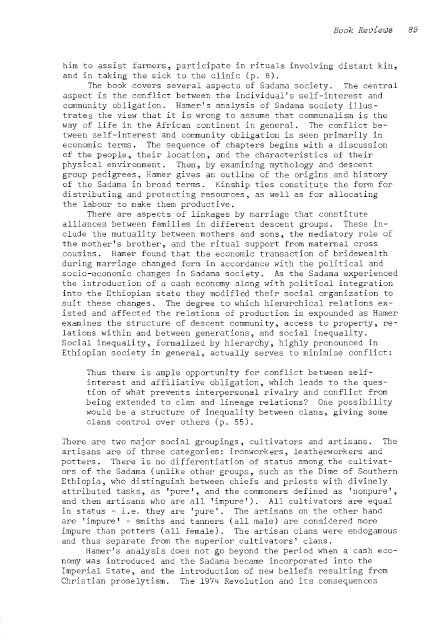CONTENTS NO.I - Institute of Social and Cultural Anthropology ...
CONTENTS NO.I - Institute of Social and Cultural Anthropology ...
CONTENTS NO.I - Institute of Social and Cultural Anthropology ...
You also want an ePaper? Increase the reach of your titles
YUMPU automatically turns print PDFs into web optimized ePapers that Google loves.
Book Reviews 89<br />
him to assist farmers,<br />
in rituals involving distant kin,<br />
<strong>and</strong> in taking the sick to the clinic (p. 8).<br />
The book covers several aspects <strong>of</strong> Sadama<br />
The central<br />
aspect is the conflict between the individual's self-interest <strong>and</strong><br />
community obligation. Hamer's <strong>of</strong> Sadama society illustrates<br />
the view that it is wrong to assume that communalism is the<br />
way <strong>of</strong> life in the African continent in<br />
The conflict between<br />
self-interest <strong>and</strong> community obligation is seen primarily in<br />
economic terms. The sequence <strong>of</strong> begins with a discussion<br />
<strong>of</strong> the , their location, <strong>and</strong> the characteristics <strong>of</strong> their<br />
physical environment. Then, by mythology <strong>and</strong> descent<br />
group , Hamer an outline <strong>of</strong> the origins <strong>and</strong><br />
<strong>of</strong> the Sadama in broad terms. Kinship ties constitute the form for<br />
distributing <strong>and</strong> protecting resources, as well as for allocating<br />
the labour to make them productive.<br />
There are aspects <strong>of</strong> linkages by marriage that constitute<br />
alliances between families in different descent groups. These include<br />
the mutuality between mothers <strong>and</strong> sons, the mediatory role <strong>of</strong><br />
the mother's brother, <strong>and</strong> the ritual support from maternal cross<br />
cousins. Hamer found that the economic transaction <strong>of</strong> bridewealth<br />
marriage form in accordance with the <strong>and</strong><br />
socio-economic changes in Sadama society. As the Sadama experienced<br />
the introduction <strong>of</strong> a cash economy with<br />
into the state they modified their social organization to<br />
suit these changes. The degree to which hierarchical relations existed<br />
<strong>and</strong> affected the relations <strong>of</strong> production is expounded as Hamer<br />
examines the structure <strong>of</strong> descent community, access to property, relations<br />
within <strong>and</strong> between generations, <strong>and</strong> social<br />
<strong>Social</strong> inequality, formalized by hierarchy, highly pronounced in<br />
Ethiopian in general, actually serves to minimise conflict:<br />
Thus there is opportunity for conflict between selfinterest<br />
<strong>and</strong> affiliative<br />
, which leads to the question<br />
<strong>of</strong> what prevents interpersonal <strong>and</strong> conflict from<br />
extended to clan <strong>and</strong> lineage relations? One possibility<br />
would be a structure <strong>of</strong> inequality between clans, giving some<br />
clans control over others (p. 55).<br />
There are two major social groupings, cultivators <strong>and</strong> artisans. The<br />
artisans are <strong>of</strong> three categories: ironworkers, leatherworkers <strong>and</strong><br />
potters. There is no differentiation <strong>of</strong> status among the cultivators<br />
<strong>of</strong> the Sadama (unlike other groups, such as the Dime <strong>of</strong> Southern<br />
LU.LULJ~n, who distinguish between chiefs <strong>and</strong> priests with divinely<br />
attributed tasks, as " <strong>and</strong> the commoners defined as 'nonpure',<br />
<strong>and</strong> then artisans who are all 'impure'). All cultivators are equal<br />
in status - i.e. they are 'pure'. The artisans on the other h<strong>and</strong><br />
are ' , - smiths <strong>and</strong> tanners (all male) are considered more<br />
impure than potters (all female). The artisan clans were endogamous<br />
<strong>and</strong> thus separate from the cultivators' clans.<br />
Hamer's s does not go beyond the period when a cash economy<br />
was introduced <strong>and</strong> the Sadama became<br />
into the<br />
Imperial State, <strong>and</strong> the introduction <strong>of</strong> new beliefs resulting from<br />
Christian proselytism. The 1974 Revolution <strong>and</strong> its consequences

















